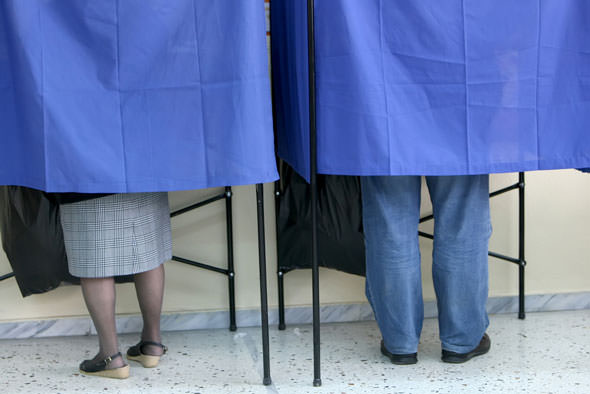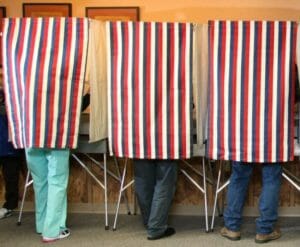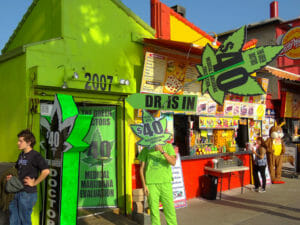Is a Widely Adopted New Voting System Ready for 2020?
An independent audit in Maryland raises key questions. Shutterstock
Shutterstock
A new precinct-based voting system being widely acquired by states and counties before 2020 that relies on printed bar codes to record votes, not handmade ink marks, may pose problems for independent efforts seeking to double-check election results.
The Express Vote, from the nation’s largest voting system vendor, Election Systems and Software (ES&S), is a ballot-marking device. It asks voters to touch a computer screen instead of using a pen to mark a paper ballot. After voters make their choices, it prints a ballot summary card with bar codes at the top and text underneath listing their votes.
Election integrity activists have criticized this approach for redefining what constitutes a paper ballot by replacing a hand-marked record with a computer-marked record. They say that moves away from direct evidence of voter intent and creates a target for hackers.
However, there’s another step in this process that has drawn little scrutiny, but could pose difficulties in independently verifying the results. Once the voter is finished, the summary card goes into a second machine, a scanner, which reads the bar codes to tabulate votes.
Currently, it appears that only one large jurisdiction, the state of Maryland, has tried to double-check this system’s accuracy. In a suburban county last year, where thousands of people used Express Vote after paper ballots ran out, the state’s third-party auditor found that 3 percent of the bar codes recorded by the system’s scanner, ES&S’s DS200 model, were unreadable. (The audit firm used the text below to assign those ballots’ votes.)
The audit firm, Boston’s Clear Ballot, is a competitor with ES&S. But its technology includes what are arguably the country’s most advanced tools to analyze digital images of ballots, such as those created by ES&S’s scan of its Express Vote ballot summary cards. Its ex-CEO cited the unreadable bar code rate, which Maryland officials confirmed.
When ES&S was asked how this gap was possible and to comment, its spokeswoman Katina Granger replied, by email, asking what the source of the 3 percent figure was. After this reporter recounted the 2018 experience from Maryland’s use of Express Votes and the DS200, she replied that ES&S was “still researching your question.”
“We have no immediate information at hand on this, so we are reaching out to the customer for information,” she said. “As a side note, ExpressVote paper ballots are always 100% auditable, and it’s the human text that is audited.”
That last point is debatable. Voters using the Express Vote are asked to verify the text on the summary card before turning them in. But, as ES&S’s website explains—“How are Ballots Read?”—their system reads bar codes to count votes, not text seen (and sometimes verified) by voters.
An apparent 3 percent discrepancy in official tabulation records—even among one part of the ballot data chain—is significant. Three percent is larger than the margin automatically triggering recounts in 19 states and the District of Columbia. It is also larger than margins in 23 other states that allow recounts under other circumstances. Partisans who challenge election results typically cite any inconsistency if it helps their side to win.
Currently, the number of jurisdictions acquiring the Express Vote ballot-marking device is much smaller than the 1,200 jurisdictions nationwide that use DS200 scanners, whose models date back a decade. (A higher-speed ES&S scanner, the DS850, is often found in these same jurisdictions for processing absentee ballots—those arriving by mail.)
In recent weeks, election officials have bought Express Votes in Tennessee (Nashville), New Jersey (a few counties), South Carolina (statewide), Delaware (statewide), Texas (a few counties), Pennsylvania (Philadelphia), Washington, D.C., and Ohio (including urban counties), according to PRNewswire and ES&S’s Facebook page. On August 23, North Carolina officials may reapprove the precinct voting system. Several weeks ago, the statewide election board modified its standards for ballot-marking devices.
However, with the lone exception of Maryland’s effort, there’s an absence of independent assessments on whether there may be audit problems with ES&S’s new precinct system, technology that may be used for years. The difficulties observed by Maryland’s auditor might be an isolated incident. Or they may point to new issues, namely, that unreadable bar code records will grow as Express Votes, paired with ES&S scanners, come online. (A similar concern could apply to other vendors’ ballot-marking devices and scanners.)
Maryland’s experience poses two big questions: Why did this happen, and do states and counties know what they are acquiring when it comes to verifying future results?
“How is it possible that 3 percent of the bar codes are unreadable?” said David Jefferson, a retired computer scientist who has worked on voting technology issues for more than two decades and is a board member of Verified Voting, a national advocacy group. “Where in this pipeline of information transfer did information get corrupted, so it was corrupted at the end [as the bar code image file]? Was it a [ballot-marking device] printer? A file copy? The scanner? Interpretive software?”
“To me, this says there is a quality issue somewhere, and until that quality issue is identified, all bets are off,” said Harri Hursti, a respected cybersecurity expert who has hacked into widely used voting systems—starting a dozen years ago. “Because, right now, it is unknown if the problem is in the Clear Ballot [auditing] side, or is this a first manifestation of a fundamental flaw in the Express Vote-DS200 architecture and how they are paired.”
A Mystery Deepens With Wide Consequences
Efforts to find an explanation from an authority not associated with any of the parties in Maryland’s independent audit raised more questions than answers.
At Maryland’s State Board of Elections, a top official confirmed that “the image itself was the problem,” referring to the bar code recorded by ES&S’s scanner. But they did not know whether the problem originated with the ballot-marking device’s initial printout, or with the later scan of the ballot summary card. (Unlike its audits elsewhere, Clear Ballot did not rescan the original paper ballots. It analyzed images created by ES&S’s scanner. If bar codes were unreadable, it used the printed text below to assign votes.)
Larry Moore, Clear Ballot’s ex-CEO, who is now working on voting by smartphone, said that the unreadable bar codes were not “when ES&S attempts to read an Express Vote card with their own equipment,” as he could not speak to their process. Rather, it was “the percent of unreadable images Clear Ballot experienced when its software tried to read a monochrome (i.e., black and white) image of bar codes on Express Vote ballots rendered at, I believe, a 200 DPI resolution.”
Moore speculated that the unreadable bar codes came from ES&S’s scanner saving the images as lower-resolution files, possibly to use less computer memory and to speed the processing time. ES&S was likely using higher-definition settings to tabulate the vote, he said, saying that scanners could use different settings for different applications.
Deploying a mix of different data-quality standards—some better, some worse—made sense to technologists who have scrutinized ES&S before, saying they have seen ES&S “cut corners” in the past, whether using cheaper commercially available parts or engineering features to resist independent efforts to probe or utilize their tools.
“That would be consistent with what we have seen,” said Margaret MacAlpine, founding partner of Nordic Innovation Labs, which advises clients against hacking and organized the “Voting Village” exhibit at this month’s Def Con hackers’ conference, where one takeaway was how voting machines frequently were built from older components.
But MacAlpine, like others asked to comment, was quick to say there could be deeper systemic issues. But she could only speculate.
“The 3 percent loss rate might just be a symptom of a deeper problem, for example, is it dumping data when it gets overwhelmed? Are these crappy memory chips?” she said. “The part that is causing this problem might not be what appears on the surface. That’s why I’d call for a closer security review of these images and not just let these be an acceptable 3 percent loss that we somehow work with. That’s ridiculous, because elections often are decided by 3 percent or less, constantly.”
Stepping back, it’s important to emphasize that Maryland’s independent audit, for all of the questions and eyebrows that it raises, has gone further than any other state with trying to double-check the accuracy of ES&S’s new balloting and tabulation process. Most election officials do not attempt to completely double-check election night results before certifying winners.
Still, election technologist-critics like Hursti said Maryland’s findings are troubling.
“There needs to be an investigation,” he said. “No one has ever investigated either the Express Vote or the DS200 independently. As a result, there is no independent study that we can refer to. The only study which has been done privately, and the result has been in circulation, about DS200, was horrible. The people who did that were not professionals, and still they found the whole system to be extremely vulnerable.”
Meanwhile, ES&S Sales Are Soaring
Another unanswered question is whether the rise of ballot-marking devices will lead to a rise in problematic ballot records and auditing problems. Yet that issue does not appear to be a concern to many election officials as they are now updating their voting systems.
For example, in North Carolina’s Wake County—home to the city of Raleigh and 13 other municipalities—election officials earlier this year bought new DS200 precinct scanners and DS850 scanners. That may position the county to acquire the Express Vote in the future, said Lynn Bernstein, a local election integrity activist and aerospace engineer. She raised that scenario last spring, she recounted, saying that election board officials essentially replied, “We’ll cross that bridge when we come to it.”
On August 23, the North Carolina State Board of Elections will consider an amendment that may restrict ballot-marking device (BMD) systems—or ballot summary cards that contain bar codes, like the Express Vote, as opposed to hand-marked paper ballots. Regardless of what the BOE decides—there has been fierce lobbying for weeks—Bernstein said the state board’s members are not steeped in the technical intricacies of the newest voting systems that they are poised to approve.
She noted that North Carolina requires voting system vendors to report performance issues, but she suspects that state officials have not heard about Maryland’s discovery that 3 percent of its digital bar code images were unreadable. What this means is some North Carolina counties, like other jurisdictions across the country, might be buying new systems that will bring unanticipated problems, including difficulties auditing future races.
“The story is once again we are rushing out and buying equipment and we don’t know whether or not it can even be verified, which is what happened with the DREs [Direct-Recording Electronic equipment],” said Chris Sautter, a Washington, D.C.-based lawyer specializing in post-Election Day recounts.
DREs are the generation of paperless voting machines bought after computer punch card malfunctions in Florida’s 2000 presidential election. They remain in use in 14 states, but most are due to be replaced before 2020—primarily for security concerns. But whether their replacements can easily be double-checked—or audited—is another question.
Maryland’s lessons, with its discovery of unreadable bar code ballot records, are hard to assess in a larger context because, among other things, no other large jurisdiction has even tried to verify the accuracy of this system.
“They’re pushing these new machines because they want to make money. That’s the bottom line,” said Sautter, referring to the rush among election officials and vendors to upgrade voting systems as a part of a response to Russian hacking in 2016’s presidential election. “They’re pushing them over hand-marked paper ballots, which address all of the security and transparency issues that everybody is worried about.”
This article was produced by Voting Booth, a project of the Independent Media Institute.
Steven Rosenfeld is the editor and chief correspondent of Voting Booth, a project of the Independent Media Institute. He has reported for National Public Radio, Marketplace, and Christian Science Monitor Radio, as well as a wide range of progressive publications including Salon, AlterNet, the American Prospect, and many others.
Your support matters…Independent journalism is under threat and overshadowed by heavily funded mainstream media.
You can help level the playing field. Become a member.
Your tax-deductible contribution keeps us digging beneath the headlines to give you thought-provoking, investigative reporting and analysis that unearths what's really happening- without compromise.
Give today to support our courageous, independent journalists.








You need to be a supporter to comment.
There are currently no responses to this article.
Be the first to respond.